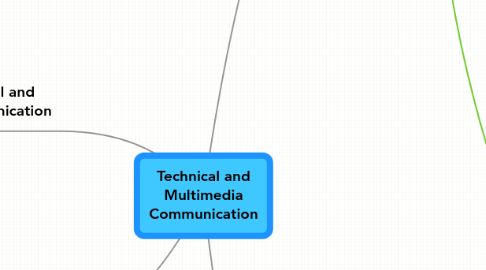
1. Activities of Technical and Professional Communication
1.1. Planning
1.2. Researching
1.3. Organizing
1.4. Drafting
1.5. Designing
1.6. Integrating visuals
1.7. Revising
1.8. Rewriting
1.9. Editing
2. Genres of Technical and Professional Communication
2.1. Emails and memos
2.2. Letters
2.3. Job search documents
2.4. Technical definitions
2.5. Technical descriptions
2.6. Websites
2.7. Technical instructions
2.8. Manuals
2.9. Proposals and requests for proposals
2.10. Informal reports
2.11. Formal reports
2.12. Presentations
3. Characteristics of Technical and Professional Communication
3.1. Rhetorical
3.1.1. PSA Rhetorical Considerations
3.1.1.1. Helpful Rhetorical Website 1
3.1.1.2. Helpful Rhetorical Website 2
3.1.1.3. Helpful Rhetorical Website 3
3.1.1.4. Helpful Rhetorical Website 4
3.1.2. Audience Uses Vary
3.2. Audience Centered
3.3. Technology Oriented
3.3.1. Creating Documents
3.3.1.1. Word Processors
3.3.1.2. Presentation Software
3.3.1.3. Graphics and Imaging Software
3.3.1.4. Web-Authoring Software
3.3.1.5. Desktop Publishing Software
3.3.1.6. Help and E-Learning Authoring Tools
3.3.1.7. Single Sourcing Programs
3.3.2. Communicating and collaborating
3.3.2.1. The Internet
3.3.2.2. The World Wide Web Network
3.3.2.3. Email
3.3.2.3.1. HTW: Sending Email Attachments
3.3.2.4. Ethics and Electronic Communication
3.3.2.5. Electronic Messaging
3.3.2.6. Groupware
3.3.3. Future of workplace writing and computer technology
3.4. Ethics and the Workplace Writer
3.4.1. Definition
3.4.1.1. Guideline #1
3.4.1.2. Guideline #2
3.4.1.3. Guideline #3
3.4.2. Ethics in Context
3.4.2.1. Situation and Perspective
3.4.2.2. Circulation
3.4.2.3. Revision and Editing
3.4.3. Code of Ethics
3.4.4. Ethics and Technology
3.4.4.1. Honesty and ethics
3.4.4.2. Bloging and writing ethics
3.4.4.3. Student writing and ethics
3.4.5. Environmental Ethics
3.4.6. Ethical Writers Checklist
3.5. Research Oriented
3.6. Professional
3.7. HTW: Visuals
3.8. HTW: Layout and Design
3.9. Concise
3.10. HTW: 5 Important Topics to Keep in Mind
3.10.1. Audience (Pg. 42)
3.10.2. Clarity (Pg. 68)
3.10.3. Coherence (Pg. 71)
3.10.4. Ethics in writing (Pg. 177)
3.10.5. Report Types (Pg. 454)
4. Solving Problems Through Technical and Professional Communication
4.1. PSA
4.1.1. Plan
4.1.1.1. Define or describe
4.1.1.2. Establish goals
4.1.1.3. Consider ethical choices
4.1.1.4. Consider formats
4.1.1.5. Identify needed information
4.1.1.6. Choose technology to assist your audience
4.1.2. Research
4.1.3. Draft
4.1.3.1. Confirm goals
4.1.3.2. Organize and draft
4.1.3.3. Design and arrange
4.1.3.4. Create and integrate visuals
4.1.4. Review
4.1.4.1. Test the usability
4.1.4.2. Solicit feedback and response from peers and colleagues
4.1.4.3. Revise and rewrite the document based on feedback
4.1.4.4. Edit the document to ensure correctness
4.1.5. Distribute
4.1.5.1. Include related documents
4.1.5.2. Confirm appropriate means to transmit document to reader
4.1.5.3. Transmit to the intended audience
4.1.5.4. Follow up to ensure the audience received the document
4.1.5.5. Assess the document's outcomes and decide on further correspondence
